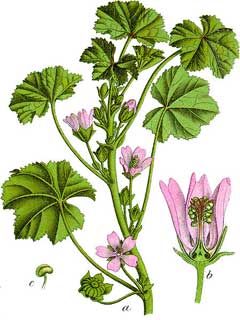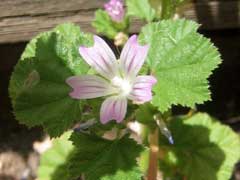 |
|
http://commons.wikimedia.org/wiki/File:Malva_neglecta_Sturm64.jpg |
 |
| http://commons.wikimedia.org/wiki/User:CarolSpears |
Translate this page:
Summary
Physical Characteristics

 Malva neglecta is a ANNUAL growing to 0.6 m (2ft).
Malva neglecta is a ANNUAL growing to 0.6 m (2ft).
See above for USDA hardiness. It is hardy to UK zone 5 and is not frost tender. It is in flower from June to September, and the seeds ripen from July to October. The species is hermaphrodite (has both male and female organs) and is pollinated by Bees, flies. The plant is self-fertile.
Suitable for: light (sandy), medium (loamy) and heavy (clay) soils and prefers well-drained soil. Suitable pH: mildly acid, neutral and basic (mildly alkaline) soils. It can grow in semi-shade (light woodland) or no shade. It prefers dry or moist soil.
UK Hardiness Map
US Hardiness Map
Synonyms
Plant Habitats
Cultivated Beds; East Wall. In. South Wall. In. West Wall. In.
Edible Uses
Edible Parts: Leaves Seed Shoots
Edible Uses: Egg Tea
Leaves and young shoots - raw or cooked[2, 9, 13, 74, 85]. A mild pleasant flavour[K], they are said to be highly nutritious[222]. They can be added in quantity to salads, and make an excellent lettuce substitute, they can also be cooked as greens[183, K]. The leaves are mucilaginous, when cooked in soups etc they tend to thicken it in much the same way as okra (Abelmoschatus esculenta)[222]. Some people find this mucilaginous texture unpleasant, especially if the leaves are cooked[K]. Immature seeds - raw or cooked[74, 85, 183]. A pleasant nutty flavour, they are nice as a nibble but too small for most people to want to collect in quantity[K]. A decoction of the roots is used as an egg-white substitute for making meringue[183]. The roots are brought to the boil in water and then simmered until the water becomes quite thick. This liquid can then be whisked in much the same way as egg whites[K]. A tea can be made from the dried leaves[85, 183].
References More on Edible Uses
Medicinal Uses
Plants For A Future can not take any responsibility for any adverse effects from the use of plants. Always seek advice from a professional before using a plant medicinally.
Antiinflammatory Antiphlogistic Astringent Demulcent Diuretic Emollient Expectorant Laxative
Poultice Purgative Salve Urinary
All parts of the plant are antiphlogistic, astringent, demulcent, diuretic, emollient, expectorant, laxative, salve[9, 222, 238]. The leaves and flowers can be eaten as part of the diet, or a tea can be made from the leaves, flowers or roots[222]. The leaves and flowers are the main part used, their demulcent properties making them valuable as a poultice for bruise, inflammations, insect bites etc, or taken internally in the treatment of respiratory system diseases or inflammation of the digestive or urinary systems[222, 238]. They have similar properties, but are considered to be inferior to the marsh mallow (Althaea officinalis), though they are stronger acting than the common mallow (M. sylvestris). They are seldom used internally[4]. The plant is an excellent laxative for young children[7].
References More on Medicinal Uses
The Bookshop: Edible Plant Books
Our Latest books on Perennial Plants For Food Forests and Permaculture Gardens in paperback or digital formats.

Edible Tropical Plants
Food Forest Plants for Hotter Conditions: 250+ Plants For Tropical Food Forests & Permaculture Gardens.
More

Edible Temperate Plants
Plants for Your Food Forest: 500 Plants for Temperate Food Forests & Permaculture Gardens.
More

More Books
PFAF have eight books available in paperback and digital formats. Browse the shop for more information.
Shop Now
Other Uses
Dye Teeth
Cream, yellow and green dyes can be obtained from the plant and the seed heads[168]. The root is used as a toothbrush[74].
Special Uses
Dynamic accumulator
References More on Other Uses
Cultivation details
A very easily grown plant, succeeding in ordinary garden soil, though it prefers a reasonably well-drained and moderately fertile soil in a sunny position. It also succeeds in dry soils. At one time this plant was often cultivated for its edible leaves[2]. Plants seem to be immune to the predations of rabbits[233]. Prone to infestation by rust fungus.
References Carbon Farming Information and Carbon Sequestration Information
Temperature Converter
Type a value in the Celsius field to convert the value to Fahrenheit:
Fahrenheit:
The PFAF Bookshop
Plants For A Future have a number of books available in paperback and digital form. Book titles include Edible Plants, Edible Perennials, Edible Trees,Edible Shrubs, Woodland Gardening, and Temperate Food Forest Plants. Our new book is Food Forest Plants For Hotter Conditions (Tropical and Sub-Tropical).
Shop Now
Plant Propagation
Seed - sow early spring or autumn in situ. Germination should take place within 2 weeks. The seed germinates in the autumn in the wild.
Other Names
If available other names are mentioned here
Native Range
TEMPERATE ASIA: Saudi Arabia, Afghanistan, Cyprus, Egypt (Sinai), Iran, Iraq, Israel, Jordan, Lebanon, Syria, Turkey, Armenia, Azerbaijan, Georgia, Kazakhstan, Kyrgyzstan, Tajikistan, Turkmenistan, Uzbekistan, Mongolia, China (w. & n.) TROPICAL ASIA: India (north), Pakistan EUROPE: Denmark, United Kingdom, Ireland, Norway, Sweden, Austria, Belgium, Switzerland, Czech Republic, Germany, Hungary, Netherlands, Poland, Slovakia, Belarus, Lithuania, Moldova, Ukraine (incl. Krym), Albania, Bulgaria, Bosnia and Herzegovina, Greece, Croatia, Italy (incl. Sardinia), North Macedonia, Montenegro, Romania, Serbia, Slovenia, Spain, France, Portugal AFRICA: Spain (Canarias), Algeria (north), Morocco
Weed Potential
Right plant wrong place. We are currently updating this section.
Please note that a plant may be invasive in one area but may not in your area so it's worth checking.
Conservation Status
IUCN Red List of Threatened Plants Status :

| Related Plants
|
| Latin Name | Common Name | Habit | Height | Hardiness | Growth | Soil | Shade | Moisture | Edible | Medicinal | Other |
| Abelmoschus esculentus | Okra | Annual | 1.0 |
5-11
| | LMH | N | M | 4 | 3 | 2 |
| Abelmoschus manihot | Aibika | Perennial | 3.0 |
8-11
| F | LMH | N | M | 4 | 1 | 2 |
| Abelmoschus moschatus | Musk Mallow,Musk Okra | Perennial | 2.0 |
8-11
| F | LMH | N | M | 2 | 3 | 3 |
| Abroma augusta | Cotton Abroma. Perennial Indian Hemp. | Shrub | 3.0 |
10-12
| F | LMH | N | M | 0 | 3 | 4 |
| Abutilon megapotamicum | Trailing Abutilon | Shrub | 2.0 |
7-10
| F | LMH | SN | M | 4 | 0 | 0 |
| Abutilon ochsenii | | Shrub | 4.0 |
7-10
| | LMH | SN | M | 3 | 0 | |
| Abutilon pictum | Abutilon, Parlour Maple, Flowering Maple, Spotted | Shrub | 5.0 |
8-10
| M | LMH | SN | M | 3 | 0 | |
| Abutilon purpurascens | | Shrub | 2.4 |
8-11
| | LMH | SN | DM | 2 | 0 | |
| Abutilon species | | Shrub | 3.0 |
7-10
| | LMH | SN | M | 3 | 0 | |
| Abutilon theophrasti | China Jute, Velvetleaf, Butterprint Buttonweed Jute, China Mallow, Indian Velvet Leaf | Annual | 1.0 |
0-0
| | LMH | SN | DM | 3 | 2 | 4 |
| Abutilon vitifolium | | Shrub | 8.0 |
7-10
| | LMH | SN | M | 3 | 0 | |
| Abutilon x hybridum | Chinese Lantern, Flowering Maple | Shrub | 3.0 |
9-11
| F | LMH | SN | M | 3 | 0 | 0 |
| Abutilon x milleri | Trailing Abutilon | Shrub | 3.0 |
7-10
| | LMH | SN | M | 3 | 0 | |
| Abutilon x suntense | | Shrub | 8.0 |
7-10
| F | LMH | SN | M | 3 | 0 | |
| Adansonia digitata | Baobab, Judas Fruit, Monkey Bread Tree | Tree | 20.0 |
10-12
| S | LMH | N | DM | 3 | 3 | 4 |
| Alcea rosea | Hollyhock | Perennial | 2.4 |
5-9
| F | LMH | N | DM | 3 | 2 | 3 |
| Althaea cannabina | Palm-leaf marshmallow | Perennial | 1.8 |
4-8
| | LMH | N | DM | 0 | 0 | 1 |
| Althaea officinalis | Marsh Mallow, Common marshmallow | Perennial | 1.2 |
3-7
| M | LMH | N | DM | 5 | 5 | 3 |
| Anoda cristata | Crested Anoda | Annual | 0.8 |
8-11
| F | LMH | N | DM | 2 | 0 | 0 |
| Bombax ceiba | Red Silk Cotton Tree, Kapok Tree | Tree | 25.0 |
10-12
| M | LMH | N | DM | 2 | 2 | 4 |
| Burretiodendron hsienmu | Hsienmu wood | Tree | 35.0 |
10-12
| S | LMH | N | M | 0 | 0 | 4 |
| Callirhoe digitata | Finger Poppy Mallow, Winecup | Perennial | 0.9 |
4-8
| | L | N | DM | 2 | 0 | |
| Callirhoe involucrata | Poppy Mallow, Purple poppymallow, Winecup, Finger Poppy Mallow | Perennial | 0.2 |
4-8
| M | L | N | DM | 3 | 2 | 0 |
| Callirhoe leiocarpa | Tall Poppy-Mallow | Annual | 0.9 |
5-9
| | L | N | DM | 2 | 0 | |
| Ceiba aesculifolia | Pochote | Tree | 25.0 |
10-12
| M | LMH | N | DM | 2 | 1 | 4 |
| Ceiba pentandra | Kapok Tree, Cotton Tree, Suma'ma | Tree | 50.0 |
10-12
| F | MH | N | DM | 3 | 3 | 5 |
| Clappertonia ficifolia | Bolo Bolo | Shrub | 2.5 |
10-12
| F | LM | N | MWe | 0 | 1 | 4 |
| Cola acuminata | Cola Nut, Kola, Bissy Nut | Tree | 20.0 |
10-12
| M | LMH | N | M | 3 | 4 | 2 |
| Cola nitida | Cola Nut, Kola, Bissy Nuts | Tree | 20.0 |
10-12
| S | LMH | SN | DM | 3 | 4 | 2 |
| Durio dulcis | Durian Marangang, Merangang, Red Durian, Tutong, Lahong | Tree | 30.0 |
11-12
| M | LMH | N | M | 4 | 0 | 2 |
|
|
Growth: S = slow M = medium F = fast. Soil: L = light (sandy) M = medium H = heavy (clay). pH: A = acid N = neutral B = basic (alkaline). Shade: F = full shade S = semi-shade N = no shade. Moisture: D = dry M = Moist We = wet Wa = water.
Now available:
Food Forest Plants for Mediterranean Conditions
350+ Perennial Plants For Mediterranean and Drier Food Forests and Permaculture Gardens.
[Paperback and eBook]
This is the third in Plants For A Future's series of plant guides for food forests tailored to
specific climate zones. Following volumes on temperate and tropical ecosystems, this book focuses
on species suited to Mediterranean conditions—regions with hot, dry summers and cool, wet winters,
often facing the added challenge of climate change.
Read More
Expert comment
Author
Wallr.
Botanical References
17200
Links / References
For a list of references used on this page please go here
Readers comment